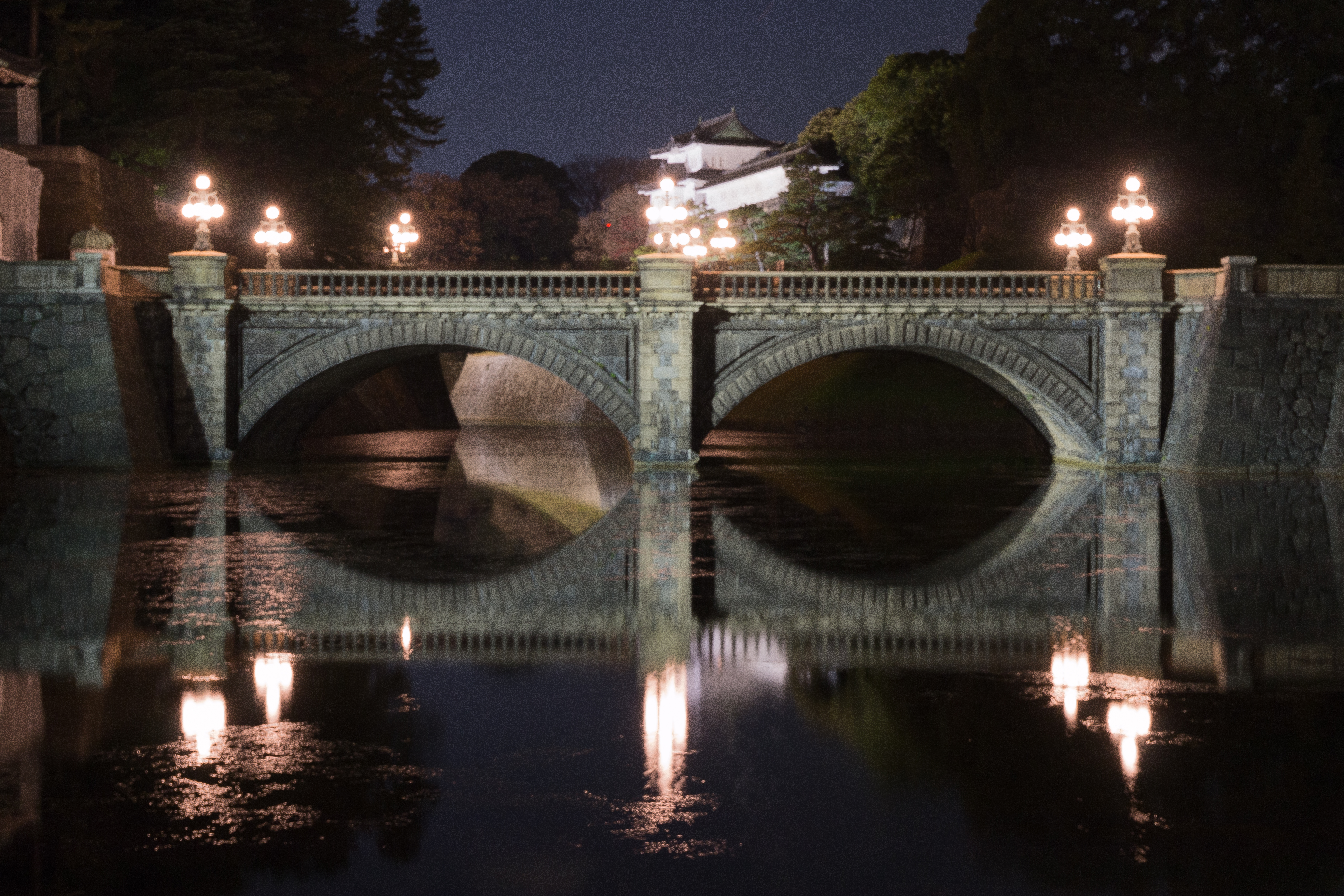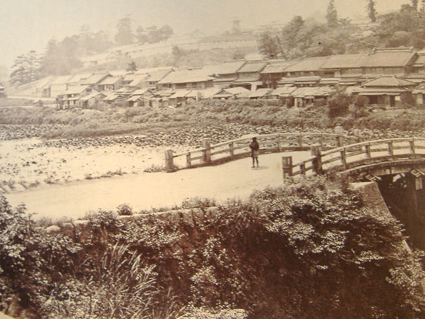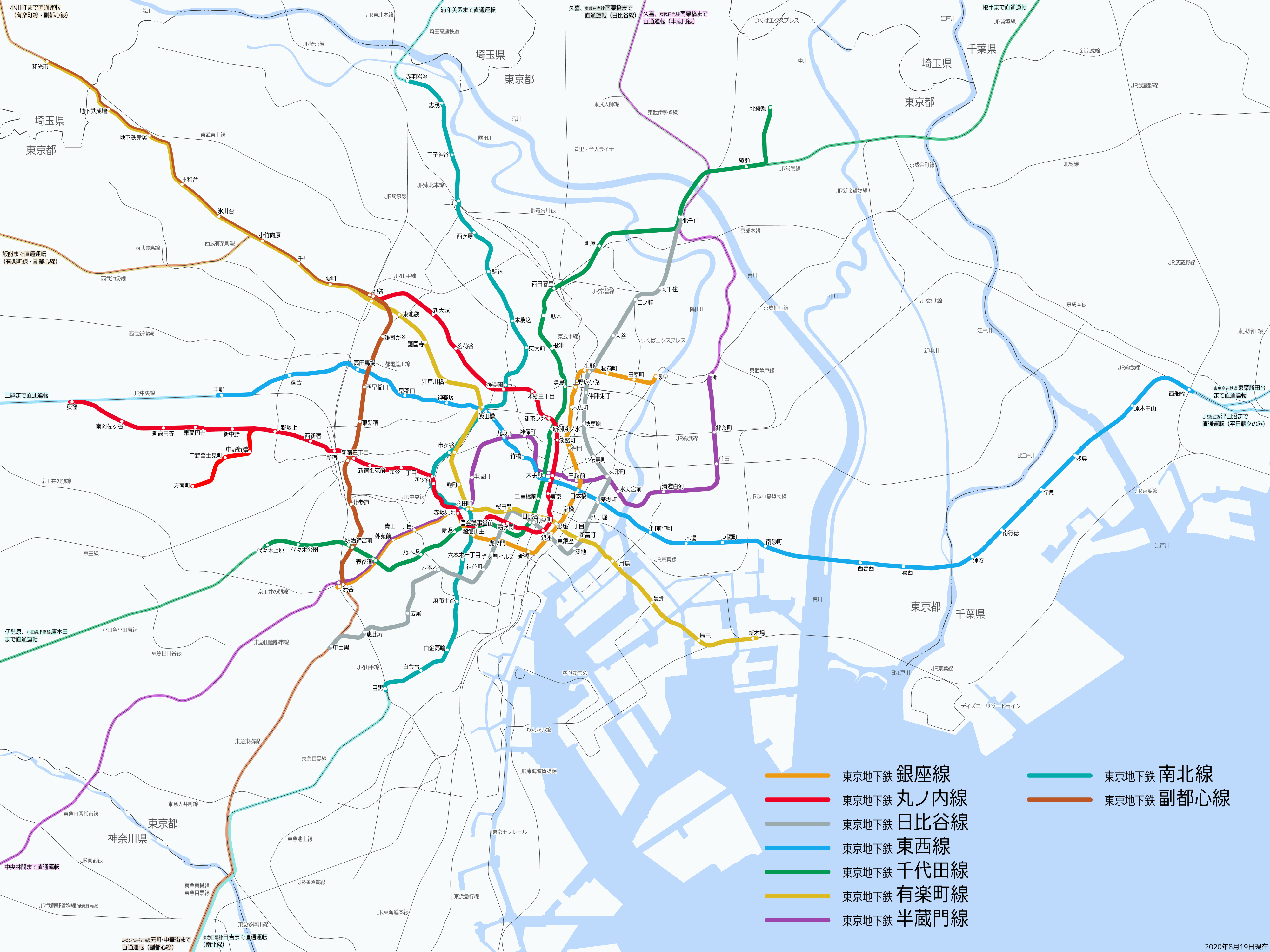|
Iidabashi Station
is a major interchange railway station which straddles Tokyo's Chiyoda, Shinjuku and Bunkyō wards. It was originally built as Iidamachi Station (albeit in a slightly different location), terminus of the then Kōbu Railway, precursor to today's Chūō Line. The Ōedo Line addition to the station in 2000 was designed by architect Makoto Sei Watanabe. Lines Iidabashi Station is served by the following above-ground and subway lines. Above ground * Chūō-Sōbu Line (JB16) Subway lines * Tokyo Metro Tōzai Line (T-06) * Tokyo Metro Yūrakuchō Line (Y-13) * Tokyo Metro Namboku Line (N-10) * Toei Ōedo Line (E-06) Station layout The JR East station has one island platform, serving the up and down local lines; there is no platform for the parallel rapid double track (for longer-distance commuter and express Chūō Line trains). The station is located on the inside of the Outer Moat. It is elevated over Mejiro-dori, a major thoroughfare from the Imperial Palace towards Ikeb ... [...More Info...] [...Related Items...] OR: [Wikipedia] [Google] [Baidu] |
Chiyoda, Tokyo
is a Special wards of Tokyo, special ward located in central Tokyo, Japan. It is known as Chiyoda City in English language, English.Profile ." ''City of Chiyoda''. Retrieved on December 28, 2008. It was formed in 1947 as a merger of Kanda, Tokyo, Kanda and Kōjimachi wards following Tokyo City's Local Autonomy Act, transformation into Tokyo Metropolis. The modern Chiyoda ward exhibits contrasting Shitamachi and Yamanote geographical and cultural divisions. The Kanda area is in the core of Shitamachi, the original commercial center of Edo-Tokyo. On the other hand, the western part of the Kōjimachi area typically represents a Yamanote district. Chiyoda consists of the Tokyo Imperial Palace, Imperial Palace and a surrounding radius of about a kilometer. As of October 2020, the ward has a p ... [...More Info...] [...Related Items...] OR: [Wikipedia] [Google] [Baidu] |
Seibu Ikebukuro Logo
{{Disambig ...
Seibu may refer to: *Seibu Holdings or a subsidiary thereof **Saitama Seibu Lions **Seibu Railway *Sogo & Seibu **Seibu Department Stores, owned by Sogo & Seibu *Seibu Kaihatsu was a Japanese manufacturer of arcade games. The company was founded in 1982 in video gaming, 1982 at Chiyoda, Tokyo, Chiyoda-ku, Tokyo, Japan as , but changed to its current name sometime in 1984. It is currently owned by Hitoshi Hamada. One ... [...More Info...] [...Related Items...] OR: [Wikipedia] [Google] [Baidu] |
Tokyo Metro Yurakucho Line
Tokyo (; ja, 東京, , ), officially the Tokyo Metropolis ( ja, 東京都, label=none, ), is the capital and largest city of Japan. Formerly known as Edo, its metropolitan area () is the most populous in the world, with an estimated 37.468 million residents ; the city proper has a population of 13.99 million people. Located at the head of Tokyo Bay, the prefecture forms part of the Kantō region on the central coast of Honshu, Japan's largest island. Tokyo serves as Japan's economic center and is the seat of both the Japanese government and the Emperor of Japan. Originally a fishing village named Edo, the city became politically prominent in 1603, when it became the seat of the Tokugawa shogunate. By the mid-18th century, Edo was one of the most populous cities in the world with a population of over one million people. Following the Meiji Restoration of 1868, the imperial capital in Kyoto was moved to Edo, which was renamed "Tokyo" (). Tokyo was devastate ... [...More Info...] [...Related Items...] OR: [Wikipedia] [Google] [Baidu] |
Tokyo Metro Tozai Line
The is a rapid transit line in Tokyo and Chiba Prefecture, Japan, owned and operated by Tokyo Metro. Its name translates to "''East-West Line"''. The line runs between Nakano in Nakano-ku, Tokyo and Nishi-Funabashi in Funabashi, Chiba Prefecture. The Tōzai Line was referred to as Line 5 during the planning stages; the seldom-used official name is . The line carries an average of 1,642,378 passengers daily (2017), making it the busiest line on the Tokyo Metro network. On maps, diagrams and signboards, the Tōzai Line is shown using the color "sky blue" ( ; #009bbf) and its stations are given numbers using the letter "T". Overview The line runs through central Tokyo from east to west via Takadanobaba, Waseda, Ōtemachi, Nihombashi, Kiba and Urayasu. It was opened as a bypass route for the Chuo Rapid Line and the Sobu Line, which had been incredibly congested at the time. It is the only Tokyo Metro line to extend into Chiba Prefecture (although the Shinjuku Line opera ... [...More Info...] [...Related Items...] OR: [Wikipedia] [Google] [Baidu] |
Chūō Main Line
The , commonly called the Chūō Line, is one of the major trunk railway lines in Japan. It connects Tokyo and Nagoya, although it is the slowest direct railway connection between the two cities; the coastal Tōkaidō Main Line is slightly faster, and the Tōkaidō Shinkansen is currently the fastest rail link between the cities. The eastern portion, the , is operated by the East Japan Railway Company (JR East), while the western portion, the , is operated by the Central Japan Railway Company (JR Central). The dividing point between the two companies is , where express trains from both operators continue to the Shinonoi Line towards the cities of Matsumoto and Nagano. Compared to the huge urban areas at either end of the Chūō Line, its central portion is very lightly traveled; the Shiojiri-Nakatsugawa corridor is only served by one limited express and one local service per hour. The Chūō Main Line passes through the mountainous center of Honshu. Its highest point (near ) ... [...More Info...] [...Related Items...] OR: [Wikipedia] [Google] [Baidu] |
Kanda River
The stretches 24.6 km from Inokashira Park in Mitaka to the Sumida River under the Ryōgoku Bridge at the boundary of Taitō, Chūō, and Sumida. Its entire length lies within Tokyo, Japan. It drains an area of 105.0 km². The government of Japan classifies it as a Class I river. Tributaries and branches The Zenpukuji, Momozono, and Myōshō-ji rivers are tributaries of the Kanda. The outer moat of the Imperial Palace is also a tributary. The Nihonbashi River is a distributary of the Kanda. Kanda River Underground Diversion Channel Construction began in the 1980s of a diversion tunnel which could temporarily store excess water which historically has been a big problem causing flooding to thousands of homes during powerful typhoons or torrential downpours. The Kanda River Underground Diversion Channel is actually one huge tunnel built under major roads. The plan is to construct a 4.5-km tunnel, 13 m wide tunnel 40 meters below street level. The first 2 km s ... [...More Info...] [...Related Items...] OR: [Wikipedia] [Google] [Baidu] |
Kagurazaka
is a neighbourhood in Tokyo, northwest of Iidabashi Station. It has a shopping street at its center, lined by numerous cafés and restaurants. It is served by Tokyo Metro Tozai Line and Toei Oedo Line. History The main road of Kagurazaka was once at the outer edge of Edo Castle, opposite the Ushigome bridge over the castle moat, and has always been busy because of this privileged location. In the early 20th century, the area was renowned for its numerous geisha houses, of which several remain today. Currently, Kagurazaka is experiencing a popularity boom due to its traditional atmosphere on the edge of modern Shinjuku ward, the existence of the original campus of Tokyo University of Science and its proximity to Waseda University. The area is also home to a number of publishing houses. While it retains a traditional Japanese atmosphere, Kagurazaka now has a significant French presence with many French expatriates living in the area due to the proximity of l'Institut Franco-J ... [...More Info...] [...Related Items...] OR: [Wikipedia] [Google] [Baidu] |
Iidabashi
is a district of Chiyoda, Tokyo, Japan. It was in the former ward of Kōjimachi, which existed in Tokyo until 1947. Etymology Iidabashi is named after a nearby bridge called Iida Bridge (, ''Iidabashi''), itself named after an Edo-period farmer, Iida Kihee (, ''Iida Kihee''). Places *Iidabashi Station *Iida Bridge *Kanda River Economy Several companies have their headquarters in Iidabashi, among them Japan Freight Railway Company, KDDI () is a Japanese telecommunications operator formed on October 1, 2000 through the merger of DDI Corp. (Daini-Denden Inc.), KDD (Kokusai Denshin Denwa) Corp. (itself a former listed state-owned enterprise privatized in 1998), and IDO Corp. It h ... Nikken Sekkei, and Shohakusha. Education operates public elementary and junior high schools. Fujimi Elementary School (富士見小学校) is the zoned elementary school for Iidabashi 1-4 chōme. There is a freedom of choice system for junior high schools in Chiyoda Ward, and so there are ... [...More Info...] [...Related Items...] OR: [Wikipedia] [Google] [Baidu] |
Koishikawa Kōrakuen Garden
is a district of Bunkyo, Tokyo. It consists of five sub-areas, . In Koishikawa are located two well regarded gardens: the Koishikawa Botanical Garden (operated by the University of Tokyo) in Hakusan, and the Koishikawa Korakuen Garden in Kōraku. Train stations for accessing this locality include , , , and Myōgadani Station. The Koishikawa arsenal was an important military installation during the Meiji era. Education Bunkyo operates the local public elementary and middle schools. Zoned elementary schools are: Kanatomi ( 金富小学校), Kubomachi ( 窪町小学校), Rekisen ( 礫川小学校), and Yanagicho ( 柳町小学校). Zoned junior high schools are: No. 1 ( 第一中学校), No. 3 ( 第三中学校), and Meidai ( 茗台中学校). Koishikawa High School is operated by the Tokyo Metropolitan Government Board of Education. In addition the metropolis operates the Koishikawa Secondary Education School. Image:Koishikawastreets.JPG, Residential street in Koishik ... [...More Info...] [...Related Items...] OR: [Wikipedia] [Google] [Baidu] |
Platform Gap
A platform gap (also known technically as the platform train interface or PTI in some countries) is the space between a train car (or other mass transit vehicle) and the edge of the station platform, often created by geometric constraints, historic legacies, or use of partially compatible equipment. Many high-quality bus rapid transit (BRT) systems also use high platforms at station stops to allow fast and efficient level boarding and alighting, but potentially leaving hazardous gaps between the platforms and the buses. Alignment setups such as Kassel curbs help to reduce platform gaps without requiring time-consuming manual alignment at each BRT station stop. Straight platforms The ideal platform would be straight and align perfectly with a train or other large vehicle. Even in this case, a small gap between the conveyances and the platform is necessary to allow the vehicles to move freely without rubbing against the platform edge. In 2007, the Long Island Rail Road regarded an ... [...More Info...] [...Related Items...] OR: [Wikipedia] [Google] [Baidu] |
Tokyo Metro
The is a major rapid transit system in Tokyo, Japan, operated by the Tokyo Metro Co. With an average daily ridership of 6.84 million passengers, the Tokyo Metro is the larger of the two subway operators in the city; the other being the Toei Subway, with 2.85 million average daily rides. Organization Tokyo Metro is operated by , a joint-stock company jointly owned by the Government of Japan and the Tokyo Metropolitan Government. The company, founded as a part of then-Prime Minister Junichiro Koizumi's policy of converting statutory corporations into joint-stock companies, replaced the , commonly known as Eidan or TRTA, on April 1, 2004. TRTA was administered by the Ministry of Land, Infrastructure and Transport, and jointly funded by the national and metropolitan governments. It was formed in 1941 as a part-nationalization of the Tokyo Underground Railway and Tokyo Rapid Railway (now both form the Tokyo Metro Ginza Line), although its oldest lines date back to 1927 wi ... [...More Info...] [...Related Items...] OR: [Wikipedia] [Google] [Baidu] |


.jpg)


